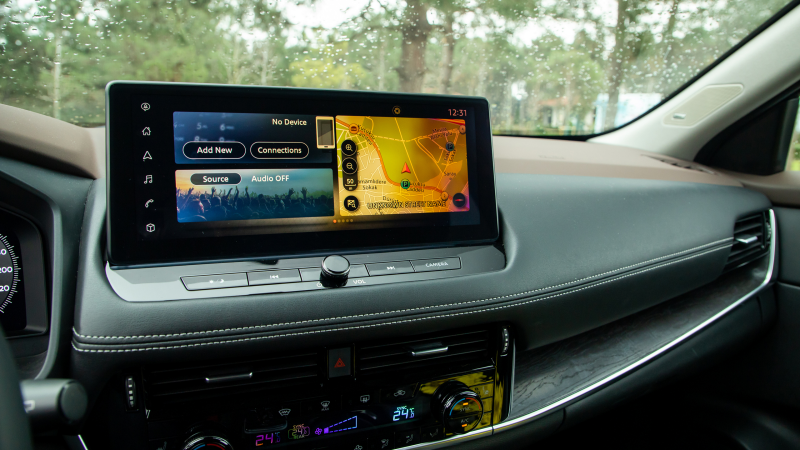What is a car infotainment system?

Nowadays, cars are much more than motor vehicles: they’re smart devices. From GPS navigation to temperature control and everything in-between, modern cars are typically rich in electronic capabilities. To navigate these functions and features, most newer vehicles come with an infotainment system, offering a single interface designed to help you get the most out of your ride.
What can car infotainment systems do?
An infotainment system (the term is a combination of “information” and “entertainment”) is a central digital system that allows you to control a wide variety of vehicle functions. It may also allow you to connect with certain devices, such as smartphones, that you have inside the vehicle with you.
Features and functions
Your car’s infotainment system is quite versatile. Depending on the system, it may allow you to manage things like:
- Hands-free calling
- Music players and radio functions
- GPS navigation
- Weather updates
- Traffic alerts
- Climate control
- Rear camera display
- Vehicle performance data
- Internet connectivity
This list is only a selection of what an infotainment system can offer, and systems tend to vary greatly depending on the make and model of the car. Often the more expensive, the more the infotech.
Control interface
The system screen is usually located front-and-center on the dashboard, where it can be easily reached by both the driver and the front passenger. While the technology itself is typically controlled by a touch screen, some systems may offer an element of voice control or even dials for certain functions.
Pairing with other devices
Car infotainment systems often allow you to connect to other electronic devices such as smartphones, smartwatches, headphones, computers and more. Your device is connected either by cables (such as USB or HDMI), or by Bluetooth. Some infotainment systems can even interface with multiple Bluetooth devices at once.
There are also infotainment apps that may be downloaded to your smartphone or other smart device, typically allowing you to mirror certain features of your phone on the car’s display screen. When connected, a range of digital services — such as calls, messages and media streaming — that you normally receive on your mobile device may also display on your car infotainment system. This could include certain notifications you have enabled on your device.
Device compatibility
Some car systems might not be compatible with all mobile devices, so it’s usually worth checking whether your smart device can pair with the in-vehicle infotainment in question.
If you're buying a used car, keep in mind that older infotainment models may not be compatible with newer devices. That said, if in-car infotainment is less of a consideration for you, an older or outdated system may further depreciate the vehicle's value and provide an opportunity for price negotiation. It may also be possible to find aftermarket infotainment systems that will work with your car.
Ambient controls
Vehicles, by design, offer a range of settings easily accessible to the driver or front passenger for controlling the internal ambience of the car. For decades, these functions — such as heating, air conditioning and internal lighting — would be solely controlled by a cluster of knobs, dials or buttons.
The modern car, by contrast, uses touchscreen technology — often, though not always, in combination with a range of manual controls, located on the steering wheel and around the center console within easy reach of the driver.
Some manufacturers veer heavily toward touchscreen technology for all but critical functions, while others offer more of a hybrid experience. As a driver, it helps to understand your comfort level with digital technology before committing to a particular model of vehicle and its in-car system.
What to consider when shopping for infotainment systems
Your own needs and preferences will usually determine which infotainment system is right for you. It’s generally a good idea to research the various options available to get a sense of which features you need, and which you can do without. What’s most important is that the infotainment system you select is both comfortable and safe to use.
Comparing in-vehicle infotainment
Although most new cars made today come with infotainment systems, it’s best not to assume that the latest model has the most advanced technology. There’s a significant amount of variation among auto manufacturers and the systems they offer.
When shopping for a car, it’s generally a good idea to spend time researching and reviewing a range of infotainment systems for the makes and models of vehicles that you have in mind. This should help you get a feel for how different systems work. Knowing the available options may help when deciding which car has the right setup for you.
You can typically find a great deal of information online, from explainer videos to user reviews. It might also be helpful to ask friends and family about their experiences with different systems. Finally, car dealerships will typically be happy to talk to you about how different infotainment systems work. They may even encourage you to take a car for a test drive to get a better sense of not just how the vehicle handles, but also of its digital features.
Of course, as with any technology, a lot depends on personal preference. Above all, infotainment systems should be functional, intuitive and help minimize distractions when driving.
Avoiding distractions
When shopping around for a car infotainment system, it’s important to choose one that’s minimally distracting. For instance, a tiny or ill-positioned screen may prove to be a safety hazard if it’s hard for the driver to read easily while on the road.
The interface matters as well. The physical interface, such as the touch screen or dials, shouldn’t require precise movements or careful hand-eye coordination, as this may distract your attention from the road. From a software perspective, it’s best to avoid systems with hard-to-navigate menus as they may become too distracting even for simple tasks like adjusting speaker volume.
Again, it helps to know your own preferences and requirements. If you have difficulty reading text of a certain size or distance, for example, or have other accessibility issues, this may impact which infotainment system works best for you.
Look at the whole package
Of course, you’re likely not just purchasing in-vehicle infotainment: you’re purchasing a car, too. Some cars might handle wonderfully but have a frustrating infotainment system, whereas other brands that you wouldn’t normally consider might offer a more slick, intuitive technology.
It all depends on what you want out of a car. For example, if you plan to make lots of calls while on the road, it may be worth looking carefully for an infotainment system with truly hands-free voice control. On the other hand, if you don’t use music streaming services or prefer to park before making calls, you might prefer a more basic system without all the bells and whistles.
In summary
Whether you’re navigating playlists or trying to parallel park in a tight spot, your vehicle’s infotainment system can add a great deal of functionality to your vehicle. It also helps consolidate controls and in-drive information in one (ideally) intuitive interface. Researching your options and carefully considering your needs can help you feel more confident about finding an infotainment system that works for you.



